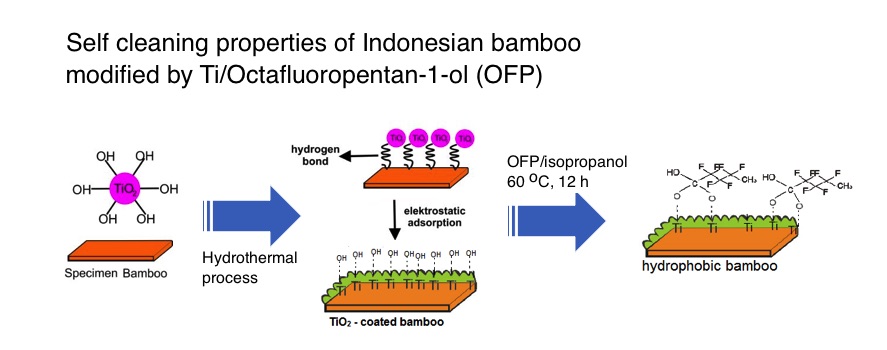Fabrication of Hydrophobic Indonesia Bamboo Modified by Octa Fluoro 1-Pentanol (OFP) Based on TiO2 Thin Film for Self-cleaning Application
Abstract

The ultra-hydrophobic surface on Indonesia bamboo timber has been successfully prepared using OFP (2,2,3,3,4,4,5,5-octafluoro-1-pentanol) as a modifier agent. The hydrothermal method has been used to fabricate anatase TiO2 film followed by OFP modification. Maximal water contact angle of 123ο has been obtained for the composition of 10 mL of OFP and 15 mL of 2-propanol (B-T-OFP10). XRD analysis showed the existence of pure anatase TiO2 film on bamboo timber, confirmed by EDS result. SEM image of a TiO2-coated and a typical ultra-hydrophobic bamboo timber revealed irregular aggregates of spherical TiO2 on the surface and compact ultra-hydrophobic surface, respectively. The optimum sample (B-T-OFP10) showed excellent mechanical stability, self-cleaning property, and flame retardancy compared to pure bamboo timber.
References
G. Hartanti, HUMANIORA, 2010, 1, 11–19.
S. Suprapti, J. Trop. For. Sci., 2010, 22(3), 287–294.
Y. Haryanto, Proceedings of the International Bamboo Workshop, 1985, 33–44.
E. Edi, P. Harnandito, R. S. Irfa'ina, Dinamika kerajinan dan Batik, 2012, 1–10.
R. Wahab, M. T. Mustafa, M. A. Salam, I. Khalid, M. S. Mat Rasat, I. U. Haq Bhat, RJPBCS, 2015, 6, 690–697.
E. Baysal, E. D. Tomak, E. Topaloglu, E. Pesman, Maderas Cienc Tecnol, 2016, 18, 253–264.
C. Hoang, T. Nguyen, D. Stanley, A. Persily, R. L. Corsi, Build Environ, 2014, 81, 226–233.
J. Li, H. Yu, Z. Wu, J. Wang, S. He, J. Ji, N. Li, Y. Bao, C. Huang, Z. Chen, Y. Chen, C. Jin, Colloids Surf A, 2016, 508, 117–123.
C. Jin, J. Li, S. Han, J. Wang, Q.Yao, Q. Sun, J Alloy Compd, 2015, 635, 300–306.
K.Tsung Lu, J Wood Sci, 2006, 52, 173–178.
Z. Li, Z. Jiang, B. Fei, Z. Cai , X. Pan, Bioresour. Technol, 2014, 151, 91–99.
Y. Xiao, M. Asce, Q. Zhou, B. Shan, J Bridge Eng, 2010, 2010, 533–541.
A. Rogerson, Edi Suhaimi, Bakar, Jegatheswaran, Ratnansingam & and K. B. Awang, PJSRR, 2016, 2, 63–79.
J. Li, H. Zheng, Q. Sun, S. Han, B. Fan, Q. Yao, C. Yan and C. Jin, RSC Adv., 2015, 5, 62265–62272.
J. F. F. Ospina, J. E. O. Borras, H. D. B. Restrepo, Appl. Sci, 2017, 7, 1253–1269.
C. Zeng, H. Wang, H. Zhou, T. Lin, RSC Adv., 2015, 5, 61044–61050.
J. Li, Y. Lu, Z. Wu, Y. Bao, R. Xiao, H. Yu and Y. Chen, Ceram Int, 2016, 42, 9621–9629.
J. Li, Q. Sun, Q. Yao, J. Wang, S. Han and C. Jin, J Nanomater, 2015, 2015, 1–9.
Y. Wang, C. E. Sims, P. Marc, M. Bachman, G. Li and N. L. Allbritton, Langmuir, 2006, 22, 8257–8262.
H. Wang, Q. Yao, C. Wang, B. Fan, Q. Sun, C. Jin, Y. Xiong, Y. Chen, Sci Rep Uk, 2016, 6, 35549–35559.
Refbacks
- There are currently no refbacks.

This work is licensed under a Creative Commons Attribution-NonCommercial 4.0 International License.








